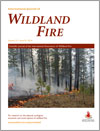International Journal of Wildland Fire
Volume 23
Number 8 2014
We highlight challenges in effective fire and burn severity assessments in the field and using remote sensing and simulation models. We suggest that instead of collapsing interacting fire effects into a single severity index, the direct effects of fire be measured and integrated into severity index keys.
Flammability results obtained on litters sampled in different vegetation types according to two different methods were compared under laboratory conditions in order to assess the effects of the reconstruction of the litter samples and of the litter composition on flammability parameters.
A layer of pine needles with the same permeability characteristics at a given mass will have approximately the same rate of heat release when combusted. The surface-to-volume ratio of needles determines how quickly the fuels will ignite.
The effect of slope on spread of a linear flame front over a pine needle fuel bed was studied. Natural convective cooling was revealed to have a remarkable effect on fuel pre-heating. A fire spread model was developed that agrees well with the experimental data under slope conditions.
This study compares the short-term effect of different fuel treatments applied in a mixed heathland in north-western Spain on fire behaviour, by assessing the resulting vegetation in experimental burns in an outdoor wind tunnel. All fuel treatments effectively modified fire behaviour, but no significant difference between treatments was observed.
In the lower Sonoran Desert of south-western Arizona, climate change and non-native plant invasions may increase the frequency and size of uncommon wildfires. Our results contribute to an improved understanding of fuel and other landscape variables that increase large fire probability in this system, particularly maximum Normalised Difference Vegetation Index, road density and elevation.
Wildfires occurring on Santa Ana event days are shown to be 3.5–4.5 times larger than on non-Santa Ana days. Relative humidity, wind speed, length of previous-day fire perimeter and day-of-fire-event indicators most strongly predict daily burned area of wildfires in southern California.
We developed 10 global models and 40 local models for daily fire danger modelling. Cross-validation was performed to evaluate the performance of the various developed models. Compared to global logistic models, both stronger predictive performance and better inferential performance were validated by geographically weighted logistic models.
Defensible space provides significant home protection during wildfire, but more than 30 m (100 ft) provides no significant additional benefit, even on steep slopes. Vegetation reduction is most effective immediately adjacent to structures. The best long-term approach to structure protection will include land use planning in addition to defensible space.
Fire agencies prefer householders to evacuate to a safer location if threatened by a wildfire. Some householders leave late and are exposed to danger. This research used two theoretical models to identify factors likely to be associated with high levels of strength of intention to evacuate.




